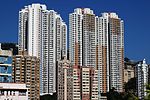
Sir Hugh Selby Norman-Walker was a British colonial official. He served in India from 1938 to 1948. Joining the Colonial Office in 1949, he successively served as an Administrative Officer and an Assistant Secretary in Nyasaland, and was seconded to the Cabinet Office of the Federation of Rhodesia and Nyasaland in 1953. He returned to Nyasaland to become Development Secretary in 1954, Deputy Financial Secretary in 1960 and Secretary to the Treasury in 1961. He remained in the government until 1965 when Nyasaland gained independence as Malawi in 1964. In 1965, Sir Hugh was posted to the Bechuanaland Protectorate as Her Majesty's Commissioner. Knighted in 1966, in September of the same year he witnessed the independence of the Protectorate as Botswana. In the next year, Norman-Walker was posted to the Seychelles as the Governor and Commander-in-Chief but his short tenure came to an end when he was assigned to succeed Sir Michael Gass, who was in turn appointed High Commissioner for the Western Pacific, as Colonial Secretary of Hong Kong in 1969. He was once rumoured to be the designated candidate to succeed Sir David Trench as the Governor of Hong Kong, but the rumour soon died out when the post was taken up by Sir Murray MacLehose, a career diplomat, in 1971.

North Lantau New Town is the newest of the nine new towns in Hong Kong, a special administrative region of China, located on the northern coast of the Lantau Island in the New Territories. It covers Tung Chung, Tai Ho Wan, Siu Ho Wan, other parts of northeast Lantau Island, and the reclaimed land along the coast between them. It is the only new town in the Islands District and the youngest new town in Hong Kong. As the commercial, residential and community facilities in the New Town are concentrated in Tung Chung, it has been renamed Tung Chung New Town in recent official government documents.

Sir Donald Collin Cumyn Luddington, was a British colonial government official and civil servant who served firstly in the Hong Kong Government and became District Commissioner, New Territories and the Secretary for Home Affairs successively, during which he had also served as an official member of the Legislative Council. He was later promoted to Oceania and was High Commissioner for the Western Pacific and Governor of the Solomon Islands during the period from 1973 to 1976. He returned to Hong Kong in 1977 to replace Sir Ronald Holmes as chairman of the Public Service Commission. He was the second person, after Sir Jack Cater, to hold the post of Commissioner of ICAC from 1978 until his retirement in 1980.

Sir David Ronald Holmes was a British colonial government official who served in Hong Kong from 1938.
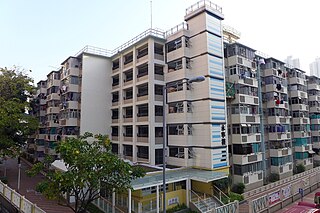
Fuk Loi Estate is a public housing estate in Tsuen Wan, New Territories, Hong Kong, located at the reclaimed land along Castle Peak Road and opposite to Nan Fung Centre, Tsuen Kam Centre and Discovery Park. It has 9 residential buildings completed between 1963 and 1967, and it is the oldest existing public housing estate in Tsuen Wan District.

The following is an overview of Public housing estates in Kwai Chung, Hong Kong, including Home Ownership Scheme (HOS), Private Sector Participation Scheme (PSPS), Sandwich Class Housing Scheme (SCHS), Flat-for-Sale Scheme (FFSS), and Tenants Purchase Scheme (TPS) estates.
The following is a list of public housing estates in Fanling Town, Hong Kong, including Home Ownership Scheme (HOS), Private Sector Participation Scheme (PSPS), Sandwich Class Housing Scheme (SCHS), Flat-for-Sale Scheme (FFSS), and Tenants Purchase Scheme (TPS) estates.

The following is a list of Public housing estates in Ma On Shan, Hong Kong, including Home Ownership Scheme (HOS), Private Sector Participation Scheme (PSPS), Sandwich Class Housing Scheme (SCHS), Flat-for-Sale Scheme (FFSS), and Tenants Purchase Scheme (TPS) estates.
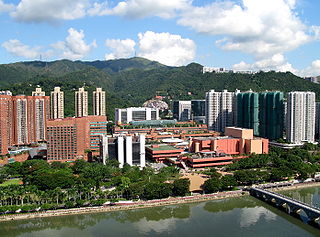
The following is a list of public housing estates in Sha Tin, Hong Kong, including Home Ownership Scheme (HOS), Private Sector Participation Scheme (PSPS), Sandwich Class Housing Scheme (SCHS), Flat-for-Sale Scheme (FFSS), and Tenants Purchase Scheme (TPS) estates.
The following shows the Resettlement Housing estates in Tsz Wan Shan, Wong Tai Sin District, Kowloon, Hong Kong.

Tai Hom Village was the largest squatter village in Kowloon, Hong Kong. Its demolition was completed in 2001, with a few structures of historical value being preserved. The name is still used to designate its former site in Wong Tai Sin District, which is awaiting redevelopment.

Edward Tyrer was a senior British colonial police officer who was Commissioner of Police, Hong Kong, from December 1966 to July 1967.
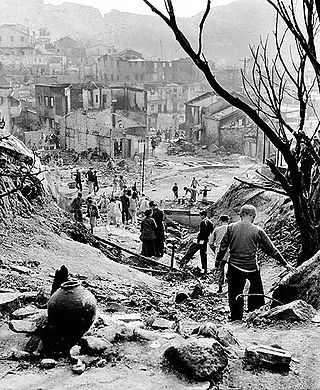
The Resettlement Department was a department of the Government of Hong Kong, responsible for constructing resettlement estates for homeless refugees, established in 1954. In 1973, the Resettlement Department and the Building Section of the Urban Services Department were merged to form the Housing Department, which acts as the Housing Authority's executive body.
The Kung Sheung Daily News was a Chinese language newspaper published in Hong Kong under British colonial rule. It was owned indirectly by Ho Shai-lai, a former Republic of China general and son of Hong Kong tycoon Robert Ho Tung. It was a pro-Kuomintang newspaper and ran according to the Minguo calendar.
The current pet keeping policy in public housing estates in Hong Kong was introduced in 2003 by the Housing Department after the outbreak of Severe Acute Respiratory Syndrome (SARS). Its objective is to improve the hygiene of public housing estates. Under the policy, public housing tenants are allowed to keep small household pets such as cats and birds but are prohibited from keeping dogs at their premises except under special circumstances, subject to the approval granted by the Housing Authority. The policy has led to debates and calls for amendments.
The following is a list of Public housing estates in Fo Tan, Hong Kong, including Home Ownership Scheme (HOS), Private Sector Participation Scheme (PSPS), Sandwich Class Housing Scheme (SCHS), Flat-for-Sale Scheme (FFSS), and Tenants Purchase Scheme (TPS) estates.

Chun Yeung Estate is a public housing estate in Fo Tan, New Territories, Hong Kong. It is the only public housing estate in Fo Tan, located at the junction of Wong Chuk Yeung Street and Kwei Tei Street. It comprises 5 blocks and 1 shopping centre with total of 4,846 flats. Its name prefix "Chun" means "horse" in English since Sha Tin Racecourse is located in Fo Tan. It was completed in 2020.

Fai Ming Estate, former name "Fanling Area 49 Public Housing Development", is a public housing estate on Fai Ming Road in Fanling, New Territories, Hong Kong, next to Yung Shing Court. It was completed in 2019 and comprises two blocks with a total of 952 flats.
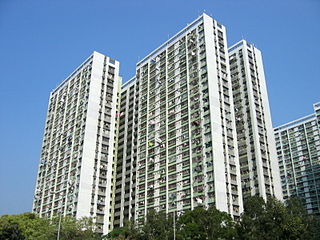
H Blocks is a 1970s block design in Hong Kong. Most of the blocks are constructed as public housing.
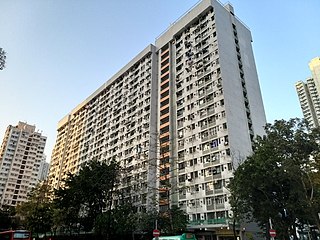
26 blocks scandal was a construction scandal in British Hong Kong during the 1980s. A total of 577 blocks of public housing estate was discovered with structural problems, of those 26 were demolished due to the imminent risk of collapse.
























